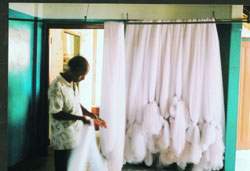Financial Times
Indian trawler attacks, increasing catch boost fish net industry
The commencement of large
scale fishing by local fisherman and the rising threat of Indian trawlers have
collectively contributed towards an upsurge in the sales of the state-owned
fish net factory, Northsea Limited.
 The
company, which supplies only 10 percent of the total demand in the region, was
set up in 1977. But it was severely damaged as a result of the heavy fighting
between government forces and the LTTE and forced to close in 1990.
The
company, which supplies only 10 percent of the total demand in the region, was
set up in 1977. But it was severely damaged as a result of the heavy fighting
between government forces and the LTTE and forced to close in 1990.
Having been revived in 2001
with the assistance of a government grant of six million rupees, the company is
currently operating with only six netting machines out of a
total of 13, and a solitary twine twisting machine out of a total of four.
Many netting machines are scarred
with bullet holes, and the walls and roofs are also in a dilapidated state.
The Northsea ice factory and
fibreglass boat factory, which were thriving industries in 1990, were completely
destroyed.
General manager C. Kuharajan
said that the influx of Indian trawlers has resulted in several drift nets of
local fishermen being repeatedly damaged, and many of them were beyond repair.
Drift nets usually consist
of a collection of several small nets, which are spread out in the ocean to form
a large fence, in which schools of fish get trapped.
"These trawlers cut through
these fishing nets in their high speed vessels, inflicting severe financial losses
to our local fisherman, which was recently estimated at Rs. 150,000 per month,"
he said.
Kuharajan said that usually
the durability of a net depended on the size of the catch. Since the catch was
good during this period, most nets were being easily damaged. On average, smaller
nets last just two months whereas the more costly big nets generally lasts two
years.
Kuharajan said that the biggest
problem the company was facing was the issue of tax on raw materials. "The LTTE
tax on a complete fishing net from Colombo is just five percent, whereas our raw
materials are taxed at 13 percent, which makes it hard for us to compete with
imports," he said.
Even fishermen in the south
preferred to buy their nets from Northsea in 1990, but due to the prevailing tax
system, they now import their nets from overseas.
Northsea is forced to bring
in twine from Colombo due to the fact that its sole twisting machine could produce
only 1,500 kg of twine per day, which is not sufficient to meet the demand of
the netting section. Plans are underway to acquire another machine from Japan,
which is likely to cost Rs. 600,000. Currently either six small nets or three
big nets could be manufactured in a day, using the existing resources. Kuharajan
said that ideally a few more netting machines could help the company meet with
the existing demand.
However, an Indian netting
machine costs five million rupees whilst the preferred Japanese machine costs
nine million rupees.
Prices of fishing nets usually
varied according to the length and thickness of each net, ranging from Rs. 1,600
- Rs. 6,000. The company currently employs only 30 people in sharp contrast to
the 200 it employed in 1990.
Each net is carefully and painstakingly
examined for any damages, and every single knot is checked to ensure that the
net is not defective. Kuharajan said that while sales picked up in the months
of March to August, September to February were relatively dry spells due to strong
winds and stormy weather in the region.
Copyright © 2001 Wijeya Newspapers Ltd. All rights reserved.
Webmaster Editorial
 The
company, which supplies only 10 percent of the total demand in the region, was
set up in 1977. But it was severely damaged as a result of the heavy fighting
between government forces and the LTTE and forced to close in 1990.
The
company, which supplies only 10 percent of the total demand in the region, was
set up in 1977. But it was severely damaged as a result of the heavy fighting
between government forces and the LTTE and forced to close in 1990.  The
company, which supplies only 10 percent of the total demand in the region, was
set up in 1977. But it was severely damaged as a result of the heavy fighting
between government forces and the LTTE and forced to close in 1990.
The
company, which supplies only 10 percent of the total demand in the region, was
set up in 1977. But it was severely damaged as a result of the heavy fighting
between government forces and the LTTE and forced to close in 1990.